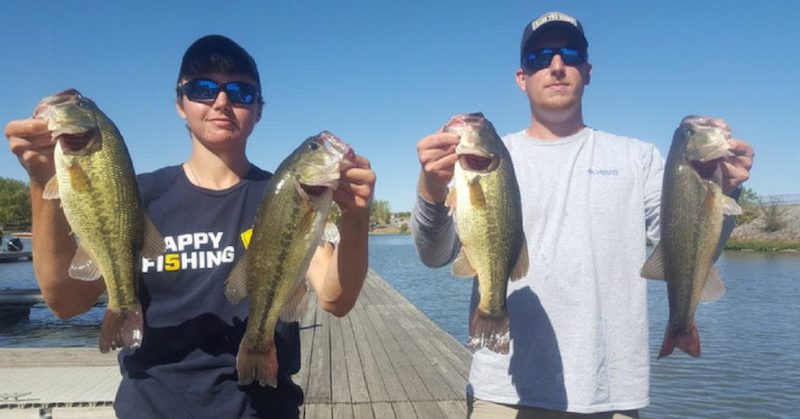3 Killer Vertical Presentations For Deep Water Bass
Studying the relationships of points, lines and angles help both geometry students and bass anglers, especially those looking for vertical presentations to catch deep water bass.
Figuring out angles in bass fishing presentations is less complicated though than toiling with a college geometry exam. Two lines become the main parts of the equation to bass anglers when they want to present their lure from Point A to Point B. The simple theory for bass fishing is to present a lure horizontally in the shallows and vertically in deeper water, but even though it’s a creature of habit, a bass sometimes befuddles the experts on this subject.
The formula for catching bass becomes even more difficult when bass migrate to deep water during the summer or winter because the fish can either suspend at certain depths or hug the bottom. Vertical presentations or a combination of a vertical-horizontal approach produces best then.
Here’s a look at three tactics to catch deep bass with vertical presentations.
Pumping Tailspinners

This technique starts horizontally but becomes more vertical as your lure drops deep. Cast the tailspinner and let it fall to the depth you estimate bass are suspending. Then raise your rod to sweep up the lure and let it fall. The height you lift your rod depends on the mood of the fish. Some days bass want a real erratic retrieve and some days they want it real slow and falling. Strikes usually occur as the lure is falling.
When working the lure through standing timber, slowly pump the tailspinner through the limbs. If you get the lure up to a limb, twitch it and the blade bait will usually pop over the obstacle. Bass will usually hit the lure after it drops from the limb.
This tactic also works well for bottom-hugging bass. You can catch these bass along humps by dropping your tailspinner to the bottom and using the same pumping retrieve.
Vertical Spooning

If you are fishing depths of 20 feet or more, position your boat over a target and drop a 3/4-ounce jigging spoon straight down to the depth you see bass suspended on your electronics. Vertical jig your spoon next to objects such as standing timber, a broken-off tree below the surface or submerged cedar trees. To minimize hang-ups in the timber, replace the treble hook of your jigging spoon with a single-barbed hook.
Once your jigging spoon reaches a desired depth or the bottom, jerk your rod to pop up the spoon and then lower your rod to follow the lure back down. Holding your rod high and keeping tension on the line to watch for strikes kills the action of the spoon as it falls. Lowering the rod tip during the spoon’s descent allows the lure to flutter more on the free-fall while maintaining enough line tautness to detect a strike.
Spotted bass and largemouth usually hit the spoon as it falls. You may not feel a tick but you notice the spoon doesn’t go all the way back to the bottom. So either it’s lying on top of a stump or a fish has it. When trying to detect a strike while vertical jigging a snag-filled cedar tree, remember if you hit something on the upswing it’s very seldom a fish, so don’t set the hook. The exception to this rule are smallmouth bass, which will smack a rising spoon.
If your home waters abound with multiple species of fish, you need to raise you rod a certain height to catch more bass. The higher you lift your rod; you are more liable to catch white bass or stripers. With less lift, you should catch more largemouth. Lift the rod about 1 foot most of the time, but pop it 3 to 4 feet if you encounter schooling bass. When the water temperature drops below 40 degrees and bass hug bottom, move your rod only 4 to 6 inches.
Finesse Worm Jigging

Select a Texas-rigged finesse worm and a 3/16-ounce bullet weight for this vertical presentation and use spinning tackle with 8-pound test line.
Cast the worm to either a boat dock or bluff and let the worm fall while keeping the bail of your spinning reel open. Leave the weight unpegged which allows the worm to generate its own unique action. As the worm follows the weight down, the lure’s straight tail causes the worm to spiral during the vertical presentations descent.
When you determine the worm has reached the depth of the suspending bass, catch the line with your finger to stop the fall. This allows the worm to make contact with the weight again. After shaking the worm a couple of time, release the line to send the worm on another spiraling chase after the sinker. Most of your strikes come when you stop the worm from falling and then let it drop again.
Looking To Try Mystery Tackle Box?
Do you want to get better at fishing, try new lures, or just surprise yourself with something fun every month? Then be sure to check out a Mystery Tackle Box Subscription for at least one month. You’ll get the best new baits plus tips, how-to videos, decals and more. With over 70,000 members this is one service you can’t pass up!




